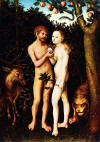100 Greatest Painters Artists Alphabetically Artists by Country Artists by Century Artists by Movement
Serpent Symbolism in Western Painting
When language was not transcendental enough to complete the meaning of a revelation, symbols were relied upon for heavenly teaching, and familiar images, chosen from the known, were made to mirror the unknown spiritual truth. - William H. Hunt
The Bible does not narrate kindly about the snake. The "serpent," symbolizes Satan.
snake - symbolizes Satan; the presence of evil, fall of man
snake in a fruit tree - signifies the mans fall from grace as well as Satan's meddling in the affairs of men.
snake cleaved in two pieces - implies destruction of heathen evil.
snake brazenly slithering across the middle of a thoroughfare or road - symbolizing the False Prophet leading the way to hell.
devious serpent peeking out of a basket, urn or pot - a spiritual reminder of Satan's presence in unusual places.
snake coiled around a skull - is a symbol for death, both of the body and the spirit.
serpent and shamrock, symbol and emblem St. Patrick. The Patron saint of Ireland. Died about 465 A.D.
snake peering out of a shoe or boot or in close proximity of footwear symbolizes that the wearer is in league with the devil or has a venereal disease
chalice with a serpent is one of many symbols and emblems of John the Evangelist
silver shield with serpent intertwined around a bloodied sword - symbolizing the False Prophet.
Snakes in the Bible
Now
the serpent was more subtle than any beast of the field which the Lord
God had made. And he said unto the woman, Yea, hath God said, Ye shall
not eat of every tree of the Garden?
And the woman said unto the serpent, We may eat of the fruit of the
trees of the Garden:
But of the fruit of the tree which is in the midst of the garden, God
hath said, Ye shall not eat of it, neither shall ye touch it, lest ye
die.
And the serpent said unto the woman, Ye shall not surely die:
For God doth know that in the day ye eat thereof, then your eyes shall
be opened, and ye shall be as gods, knowing good and evil.
And when the woman saw that the tree was good for food, and that it was
pleasant to the eyes, and a tree to be desired to make one wise, she
took of the fruit thereof, and did eat, and gave also unto her husband
with her, and he did eat.
And the Lord God said unto the woman, What is this that thou hast done? And the woman said, The serpent beguiled me, and I did eat.
The Meaning of Sacred Symbols in Paintings. Most prominently featured symbols and their meaning:
☼☼☼☼☼
☼☼☼☼☼
If you feel you have worthwhile information you would like to contribute we would love to hear from you. We collect essential biographical information and artist quotes from folks all over the globe and appreciate your participation. When submitting please, if possible, site the source and provide English translation. Email to historyofpainter@gmail.com
© HistoryofPainters.com 2017
